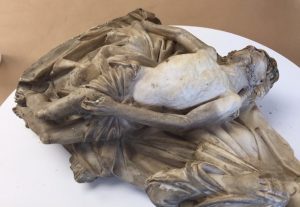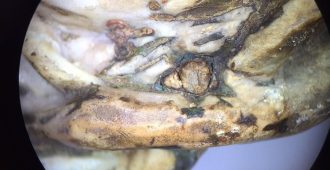
The Vanderbilt Fine Arts Gallery recently learned more about its Rhenish Pietà, created by an unknown German artist in the 15th century. This sculpture is made of alabaster and is covered in centuries worth of grime, masking the fine details of the Pietà.
The Gallery’s Registrar and Collections Manager, Kali Mason, invited Carolina Conservation to come and examine the sculpture on site, where it was determined that the sculpture would greatly benefit from a surface cleaning. Surface cleaning is a time intensive, laborious, and meticulous process that involves using a small cotton swab to gently clean the surface of the sculpture with pH adjusted water. These treatments help to stabilize and/or repair objects but do not damage the original integrity of the objects.

During this process, the conservator was careful to study all areas of the sculpture with a microscope, in hopes of seeing (and not disturbing) any original pigments that remained on the sculpture. The surface cleaning has revealed multiple areas of original pigment in red, gold, and green all throughout the sculpture. “This is very exciting as we were previously unable to see these pigments due to the condition of the sculpture,” said Mason. “The revelation of the sculpture’s original pigments will be useful information for future classes and exhibitions.”
This sculpture will be on view in the upcoming exhibition, The Artist’s Workshop in Medieval and Renaissance Europe in 2021.